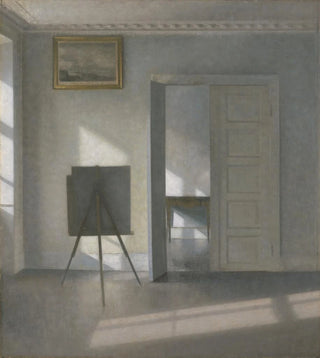Art print | Interior with an easel: Bredgade 25 - Vilhelm Hammershøi


View from behind

Frame (optional)
Interior with an easel: Bredgade 25 - Vilhelm Hammershøi – Captivating introduction
In the fascinating world of art, some works captivate through their simplicity and depth. "Interior with an easel: Bredgade 25" by Vilhelm Hammershøi is a perfect example. This canvas, depicting an intimate interior, invites the viewer to enter a world where silence and light play a fundamental role. The artist, through this piece, transports us to a space where everyday life transforms into visual poetry. Every detail, every nuance of color seems to tell a story, an invitation to contemplation. Hammershøi, with his delicate approach, encourages us to slow down, observe, and feel the atmosphere emanating from this scene.
Style and uniqueness of the work
Hammershøi's style is often characterized by a palette of soft colors and minimalist compositions. In "Interior with an easel: Bredgade 25," light plays a central role, filtering through the windows and creating shadow plays that enhance the depth of the space. The bare walls, carefully arranged furniture, and the easel in the foreground blend into a visual harmony that evokes palpable serenity. The artist captured the essence of domestic life while infusing an almost spiritual dimension into his work. The solitude and tranquility emanating from this piece invite introspection, reflection on the passing of time, and suspended moments.
The artist and his influence
Vilhelm Hammershøi, an emblematic figure of Danish art in the early 20th century, established himself with his unique style and poetic vision of daily life. Influenced by the masters of the past, he nonetheless developed a personal aesthetic that is entirely his own. Hammershøi often explored themes of intimacy and solitude, concepts that resonate deeply within his work. His influence extends far beyond Denmark's borders, impacting generations of contemporary artists seeking to explore similar spaces of silence and reflection. Through his paintings, he reminds us that beauty often resides in

Matte finish

View from behind

Frame (optional)
Interior with an easel: Bredgade 25 - Vilhelm Hammershøi – Captivating introduction
In the fascinating world of art, some works captivate through their simplicity and depth. "Interior with an easel: Bredgade 25" by Vilhelm Hammershøi is a perfect example. This canvas, depicting an intimate interior, invites the viewer to enter a world where silence and light play a fundamental role. The artist, through this piece, transports us to a space where everyday life transforms into visual poetry. Every detail, every nuance of color seems to tell a story, an invitation to contemplation. Hammershøi, with his delicate approach, encourages us to slow down, observe, and feel the atmosphere emanating from this scene.
Style and uniqueness of the work
Hammershøi's style is often characterized by a palette of soft colors and minimalist compositions. In "Interior with an easel: Bredgade 25," light plays a central role, filtering through the windows and creating shadow plays that enhance the depth of the space. The bare walls, carefully arranged furniture, and the easel in the foreground blend into a visual harmony that evokes palpable serenity. The artist captured the essence of domestic life while infusing an almost spiritual dimension into his work. The solitude and tranquility emanating from this piece invite introspection, reflection on the passing of time, and suspended moments.
The artist and his influence
Vilhelm Hammershøi, an emblematic figure of Danish art in the early 20th century, established himself with his unique style and poetic vision of daily life. Influenced by the masters of the past, he nonetheless developed a personal aesthetic that is entirely his own. Hammershøi often explored themes of intimacy and solitude, concepts that resonate deeply within his work. His influence extends far beyond Denmark's borders, impacting generations of contemporary artists seeking to explore similar spaces of silence and reflection. Through his paintings, he reminds us that beauty often resides in






